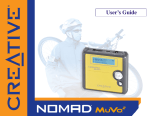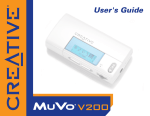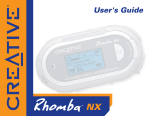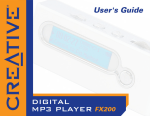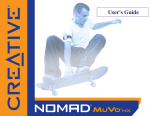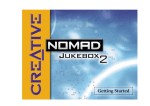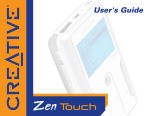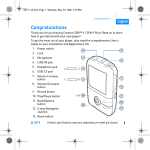Download Creative MUVO2 FM User`s guide
Transcript
User’s Guide Creative MuVo2 FM Information in this document is subject to change without notice and does not represent a commitment on the part of Creative Technology Ltd. No part of this manual may be reproduced or transmitted in any form or by any means, electronic or mechanical, including photocopying and recording, for any purpose without the written permission of Creative Technology Ltd. The software described in this document is furnished under a license agreement and may be used or copied only in accordance with the terms of the license agreement. It is against the law to copy the software on any other medium except as specifically allowed in the license agreement. The licensee may make one copy of the software for backup purposes only. The Software License Agreement is found in a separate folder on the Installation CD. Copyright © 2004 by Creative Technology Ltd. All rights reserved. Version 1.0 July 2004 The Creative logo, Creative MediaSource and MuVo are trademarks or registered trademarks of Creative Technology Ltd. in the United States and/or other countries. Microsoft, MS-DOS, Windows and the Windows logo are registered trademarks of Microsoft Corporation. Intel and Pentium are registered trademarks of Intel Corporation. All other products are trademarks or registered trademarks of their respective owners and are hereby recognized as such. All specifications are subject to change without prior notice. Actual contents may differ slightly from those pictured. Contents 1 Before You Begin Introduction................................................................................................................................................. 1-1 Minimum System Requirements ........................................................................................................... 1-1 2 A Tour of Your Player Your Player at a Glance........................................................................................................................... Using the Menu Button............................................................................................................................ Select.................................................................................................................................................... Volume................................................................................................................................................ Your Wired Remote................................................................................................................................ 2-1 2-2 2-2 2-2 2-5 3 Getting Started Step 1: Setting Up Your Computer ..................................................................................................... 3-1 Step 2: Inserting the Battery................................................................................................................... 3-2 Step 3: Charging the Battery.................................................................................................................. 3-3 Using the Power Adapter ............................................................................................................. 3-3 Using the USB Cable....................................................................................................................... 3-4 Power Source and Level Indicators ........................................................................................... 3-5 Step 4: Transferring Audio and Data................................................................................................... 3-6 Downloading From the Internet................................................................................................. 3-8 Ripping Audio CDs.......................................................................................................................... 3-9 Step 5: Stopping Your Player Properly ............................................................................................. 3-10 Step 6: Connecting the Earphones and Wired Remote.............................................................. 3-11 Connecting the Earphones ......................................................................................................... 3-11 Connecting the Wired Remote................................................................................................ 3-12 i 4 Using Your Player Turning Your Player On/Off.................................................................................................................. 4-1 Enabling a Mode ......................................................................................................................................... 4-2 Playing Audio Tracks ................................................................................................................................ 4-3 Deleting Audio Tracks ............................................................................................................................. 4-4 Managing Audio Tracks............................................................................................................................ 4-4 Listening to FM Radio............................................................................................................................... 4-5 Audio and FM Recording......................................................................................................................... 4-9 Recording Audio .............................................................................................................................. 4-9 Recording FM Radio...................................................................................................................... 4-10 Playing Recordings................................................................................................................................... 4-11 Play Modes................................................................................................................................................. 4-12 Repeat Track................................................................................................................................... 4-12 Repeat All......................................................................................................................................... 4-13 Track Once...................................................................................................................................... 4-13 Shuffle Repeat.................................................................................................................................. 4-13 Shuffle Once .................................................................................................................................... 4-13 Normal.............................................................................................................................................. 4-13 Enhancing Audio....................................................................................................................................... 4-14 EQ ..................................................................................................................................................... 4-14 Defining Custom EQ .......................................................................................................... 4-14 Setting Preferences.................................................................................................................................. 4-16 Settings ............................................................................................................................................. 4-16 Locking and Unlocking Your Player................................................................................................... 4-17 Locking Your Player...................................................................................................................... 4-17 Unlocking Your Player ................................................................................................................. 4-17 Formatting Your Player ......................................................................................................................... 4-18 ii 5 Software Applications About Creative MediaSource and Creative AudioSync Wizard ................................................ 5-1 Appendixes A Onscreen Diagram and Icon Guide Play Status Icons......................................................................................................................................... A-1 Information Diagrams.............................................................................................................................. A-2 B Frequently Asked Questions Usage ............................................................................................................................................................. B-1 Updates......................................................................................................................................................... B-3 C General Specifications Size (WxHxD)........................................................................................................................................... LCD............................................................................................................................................................... Playback Formats...................................................................................................................................... Signal-to-Noise Ratio............................................................................................................................... Harmonic Distortion Output ............................................................................................................... Frequency Response................................................................................................................................ Earphones Output.................................................................................................................................... USB Connectivity...................................................................................................................................... C-1 C-1 C-1 C-1 C-1 C-1 C-1 C-2 iii Before You Begin Before You Begin Introduction Thank you for purchasing Creative’s new multi-format player, Creative MuVo2 FM! Your player can store thousands of songs in its music library, and comes equipped with a USB 2.0 connector, so you can transfer audio tracks and data quickly and easily. Minimum System Requirements ❑ Microsoft® Windows® XP, Windows Millennium Edition (Me), Windows 2000 or ❑ ❑ ❑ ❑ ❑ ❑ Windows 98 Second Edition (SE) Intel® Pentium® II 233 MHz, or AMD-K6®-2 266 MHz 32 MB RAM 30 MB available hard disk space CD-ROM/DVD-ROM drive USB port (USB 2.0 port recommended for faster transfer speeds) Internet access for Music Service Provider support (optional) The software applications on the Creative MuVo2 FM CD may have higher requirements for basic functionality. Refer to each application’s documentation for details. Before You Begin 1-1 A Tour of Your Player A Tour of Your Player Your Player at a Glance Liquid Crystal Display (LCD) Menu button Play/Pause button Front View Power adapter connector USB port Earphone connector Top View A Tour of Your Player 2-1 Using the Menu Button Select Volume The Menu button (Figure 2-1) is one of the most important features of your player. In this document, we will use the term, “Select”, to mean that you should move the Menu button towards the left or right to browse through options, and then select an option by pressing the Menu button. Figure 2-1: Menu button You can also adjust volume levels with the Menu button. Move the Menu button upward to increase volume or downward to decrease volume. A Tour of Your Player 2-2 Button MENU What It Does ❍ Displays Menu options on the LCD. Usage Tips ❍ For more information on using the Menu button, see "Using the Menu Button" on page 2-2. ❍ PLAY/PAUSE ❍ ❍ Indicator PREVIOUS NEXT VOLUME INCREASE VOLUME DECREASE Turns your player on and off. Enables various functions, depending on the mode you are in. In Music mode, press this button to start playing tracks, and press again to pause playback. ❍ In Microphone mode, press this button to start or end a recording. ❍ In FM Radio mode, press this button to switch between FM Preset and Manual Scan views. What It Means Usage Tips ❍ Goes to the beginning of the current track, or to the previous track. ❍ Goes to the next track. ❍ Increases the volume. ❍ Decreases the volume. ❍ Move and hold the Menu button towards to move back within a track. ❍ Move and hold the Menu button towards to move ahead within a track. ❍ Move and hold the Menu button towards to increase the volume quickly. ❍ Move and hold the Menu button towards to decrease the volume quickly. A Tour of Your Player 2-3 Connector/Port What It Does Usage Tips POWER ADAPTOR CONNECTOR USB PORT EARPHONE CONNECTOR ❍ Connect your power adaptor to this connector. ❍ Connect your USB cable to this port. ❍ Connect your earphones or wired remote to this connector. A Tour of Your Player 2-4 Your Wired Remote In Music mode, each button on the wired remote has the same function as its respective button on the player. The wired remote lets you access the controls of your player without having to take the player out of your bag. Earphone jack for connecting to your earphones Power On /Play /Pause Power Off /Stop Wired remote jack for connecting to your player’s earphone connector. Previous Lock switch Note: This switch only locks the buttons on the remote control. Next Volume Up Volume Down Figure 2-2: Your wired remote. A Tour of Your Player 2-5 Getting Started Getting Started Step 1: Setting Up Your Computer DO NOT connect your player to your computer before installing the software. 1. Ensure that your player is NOT connected to your computer 2. Insert the Creative MuVo2 FM CD into your CD-ROM/DVD-ROM drive. Your CD should start automatically. If it does not, follow the steps below: i. Start Windows Explorer. ii. On the left pane, click the My Computer icon. iii. Right-click the CD-ROM/DVD-ROM drive icon, and then click AutoPlay. 3. Follow the instructions on the screen to complete the installation. Creative MediaSource™ and Windows 98 SE drivers (only if applicable) will be installed on your computer. 4. When prompted, restart your computer. Getting Started 3-1 Step 2: Inserting the Battery Insert the supplied battery into your player as shown below in Figure 3-1. Figure 3-1: Inserting the battery. Getting Started 3-2 Step 3: Charging the Battery You can charge your battery by connecting your player to a power outlet using the supplied power adapter, or by connecting your player to your computer’s USB port using the supplied USB cable. Using the Power Adapter Connect one end of the power adapter to the wall outlet and the other end to your player’s power adapter connector, as shown in Figure 3-2. Check the battery icon to see when the battery is fully charged. Charging your battery for the first time takes about three hours. DO NOT charge your player’s battery via the USB port until after you have installed the software. The amount of playback time available depends on various factors, such as the type of earphones you are using. For more information, see "Usage" on page B-1. Figure 3-2: Connecting the player to the wall outlet. Getting Started 3-3 Using the USB Cable You can also charge your player’s battery using the supplied USB cable. Connect the USB cable to your player and computer’s USB ports, as shown in Figure 3-3. DO NOT charge your player’s battery via the USB port until after you have installed the software. Figure 3-3: Connecting the player using the USB cable. You can disconnect your player from your computer even if the battery is not fully charged. 1. In Windows Explorer, right-click the Removable Disk icon and click appears on your player's LCD. Eject to start charging the battery. 2. When appears on your player's LCD, your player is fully charged. 3. Safely disconnect your player from your computer. For more details, see "Step 5: Stopping Your Player Properly" on page 3-10. Getting Started 3-4 Power Source and Level Indicators Your player displays one of the following icons, depending on the battery’s charged status or the power source (battery or external power). Icon What the icon means ❍ Your player is running from battery power. ❍ Your player’s battery is 60% full. ❍ Your player’s battery is 30% full. ❍ Your player’s battery is empty. ❍ Your player is running from external power. Notes ❍ This battery state icon shows that the battery is fully charged. ❍ Charging your battery when it is 30% full may help prolong your battery’s life. ❍ Charge your battery at the earliest opportunity. ❍ ❍ Your player is running from external power and is charging the battery. Charge the battery fully before disconnecting the player from the power outlet. ❍ While charging, the icon will alternate between this icon and a battery state icon, showing the approximate level of charge. Getting Started 3-5 Icon What the icon means ❍ Step 4: Transferring Audio and Data You can use your player as a portable storage device to store any data file, such as documents, presentations and photos. Your player is running from external power and has finished charging the battery. Notes ❍ To use battery power, disconnect the player from the power outlet. Audio selections have been preloaded to your player to get you started quickly. If you wish to listen to music immediately, see "Playing Audio Tracks" on page 4-3. If you wish to download additional music tracks to your player, you can either download music tracks from Internet music sites (see "Downloading From the Internet" on page 3-8) or rip them from your audio CDs to create digital files on your computer. For more information, see "Ripping Audio CDs" on page 3-9. Music files can be encoded into the supported formats (MP3, WMA or WAV file formats), and then transferred to your player with Creative MediaSource Organizer. Data files can also be transferred to and stored in your player, for example, you can transfer a large data file from one computer to another. Data can be transferred to your player with the Creative MediaSource application. To transfer audio and data with Creative MediaSource Before starting any extensive file transfer activity, be sure that your player is powered via the power adapter. 1. Connect your player to your computer’s USB port using the supplied USB cable. 2. Launch Creative MediaSource on your computer. Getting Started 3-6 3. On the left pane, locate and select the files you want to transfer to your player. Using the standard drag-and-drop method, transfer the files to your player. For information about transferring DRM protected WMA files, refer to "Usage" on page B-1. 4. After the transfer is complete, make sure you stop your player properly before disconnecting it from your computer. For more details, see "Step 5: Stopping Your Player Properly" on page 3-10. Getting Started 3-7 Downloading From the Internet To get MP3 files from the Internet, use a search engine to locate sites with MP3 content. You can also try out these sites (web sites listed here are correct at the time of this document’s release): ❍ It may be illegal to encode MP3 files for trade or sale unless you have the express or explicit permission of the copyright holder(s). Walmart.com http://www.music downloads.walmart.com ❍ Buy.com ❍ Epitonic.com http://www.buy.com ❍ Bestbuy.com ❍ Soundbuzz.com http://www.bestbuy.com http://www.soundbuzz.com http://www.epitonic.com Follow the instructions on the site to download the music files to your computer. When connecting to your Internet Service Provider, usage charges are incurred. Getting Started 3-8 Ripping Audio CDs The first phase in making an MP3 file is extracting audio data from an audio CD. To extract audio data, you will need a CD-ROM drive that can extract digital audio data, and a program known as a ripper. With Creative MediaSource Organizer, you can rip tracks from most audio CDs. This program uses the CD-ROM drive to read the audio tracks from the audio CD and stores it on your hard disk. The time needed for a successful audio extraction depends on: • CD-ROM drive speed • defects, like scratches on the audio CD • error-checking features on the CD-ROM drive Encoding is the second phase of making an MP3 file. Encoders are used to convert the stored audio tracks, usually WAV files, into MP3 files. MP3 encoding is a lossy compression methodology where some data is considered inaudible and is removed before encoding. Using the standard sampling rate and bitrates will ensure that your MP3 files retain much of their audio quality. The standard bitrate of most MP3 files is 128 Kbps, although some are set higher, at 160 or 192 Kbps. Higher bitrates will result in larger MP3 file sizes, with better audio quality. Use Creative MediaSource Organizer to extract audio tracks and encode MP3s. See the Creative MediaSource Organizer online Help for more information. Getting Started 3-9 Step 5: Stopping Your Player Properly To stop your player in Windows XP, Windows Me or Windows 2000 Click the Safely Remove Hardware icon on the Taskbar, click Safely remove USB Mass Storage Device (Figure 3-4), and disconnect your player when you are prompted to do so. Figure 3-4: Stopping your player in Windows XP, Windows Me or Windows 2000 To stop your player in Windows 98 SE In Windows Explorer, right-click the Removable Disk icon (Figure 3-5), click the Eject option, and disconnect your player when you are prompted to do so. Figure 3-5: Stopping your player in Windows 98 SE Getting Started 3-10 Step 6: Connecting the Earphones and Wired Remote You can connect the earphones directly to your player’s earphone connector for hours of listening pleasure (see Figure 3-6 below). You can also have convenient one touch access to your player’s controls by connecting the earphones to your player via the wired remote (see "Connecting the Wired Remote" on page 3-12). For more details on using the wired remote, see "Your Wired Remote" on page 2-5. Connecting the Earphones Connect your earphones and player as shown below in Figure 3-6. For your safety and the safety of others, do not use earphones while driving or cycling. Earphones Earphone jack Earphone connector Figure 3-6: Connecting your earphones. Getting Started 3-11 Connecting the Wired Remote Connect your earphones, wired remote and player as shown below in Figure 3-1. Earphones Earphone jack Wired remote jack Using other wired remotes with your player is not recommended. Earphone connector Wired Remote Figure 3-7: Connecting the player to the wired remote. Getting Started 3-12 Using Your Player Using Your Player Your player can function in Music, Microphone or FM Radio mode. To switch modes, see "Enabling a Mode" on page 4-2. Your player also has Play Modes that allow you to change how your tracks are played back. For more information, see "Play Modes" on page 4-12. Turning Your Player On/Off To turn on your player Press and hold the Play/Pause button until your player turns on. The CREATIVE logo appears onscreen, followed by the MuVo2 FM logo. To turn off your player If your player contains no audio tracks, the message "No Music" appears on the screen. Press and hold the Play/Pause button until the Power Off message appears. The Power Off message disappears when the player turns off. Using Your Player 4-1 Enabling a Mode Your player can function in Music, Microphone or FM Radio mode. Different modes enable you to select different functions. 1. Press the Menu button. The menu similar to Figure 4-1 appears. 2. Select the Music icon The term "Select" is used throughout this document. To understand its usage, see "Select" on page 2-2. or FM Radio icon , Microphone icon Figure 4-1 . Using Your Player 4-2 Playing Audio Tracks Audio selections have been preloaded to your player to get you started quickly. If you wish to listen to music immediately, simply press the Play/ Pause button . It is simple to play back audio tracks. In Music mode, your player will display the elapsed time, track number and file name of the track. Audio tracks are sorted in alphanumeric order. To add audio tracks to your player, see "Step 4: Transferring Audio and Data" on page 3-6. Play mode icon EQ Status Lock Elapsed time Battery level indicator Play status icon Current playing track name Music mode Figure 4-2 To play tracks 1. Press the Menu button. 2. Select the Music icon. A screen similar to Figure 4-2 appears. 3. Select the track you want to play and press the Play/Pause button . To pause a track Press the Play/Pause button . To stop a track Press the Play/Pause button to pause the track, and then move the Menu button towards the right. The Stop icon appears onscreen. Using Your Player 4-3 Deleting Audio Tracks This action permanently deletes tracks from your player. To delete a track 1. Press the Menu button. 2. Select the Music icon. Select the track that you want to delete. 3. Press the Menu button again. 4. Select the Delete icon (Figure 4-3). A list appears. 5. Select the Confirm Delete icon (Figure 4-4). The track’s name appears onscreen and the track is permanently deleted from your player. Managing Audio Tracks Figure 4-3 Figure 4-4 For more advanced song management tasks, such as creating and managing playlists, you can use Creative MediaSource Organizer. Creative MediaSource Player/Organizer is your digital audio center for playing, creating, organizing and transferring digital audio. To launch Creative MediaSource Player/Organizer, double-click the Creative MediaSource Player/Organizer icon on your desktop. For more information about using Creative MediaSource, refer to its online Help. Using Your Player 4-4 Listening to FM Radio With your player, you can listen to your favorite radio station. Your player can automatically scan for stations available in your region, and store the stations as channels for you. In FM Radio mode, your player will display the current radio channel and its preset number. FM radio channel Battery Status Stereo/Mono Indicator FM Radio mode Preset number To change the FM region Perform these steps when scanning for stations for the first time. 1. Press the Menu button. 2. Select the Settings icon (Figure 4-5). A list appears. Figure 4-5 3. Select the FM Region icon (Figure 4-6). A list appears. 4. Select the region that you are in. Figure 4-6 Using Your Player 4-5 To perform an autoscan and autosave 1. Select the FM Radio icon (Figure 4-7). A radio frequency appears on the LCD screen (Figure 4-8). Figure 4-7 2. Press the Menu button again. Figure 4-8 3. Select the Autoscan icon (Figure 4-9). The player scans and stores channels it detects. At the end of the autoscan, it automatically saves all channels and plays the first channel. Figure 4-9 To manually set a preset channel 1. Select the FM Radio icon (Figure 4-10). A radio frequency appears on the LCD screen (Figure 4-11). Figure 4-10 2. If you see a preset channel (Figure 4-11), press the Play/Pause button to switch to Manual Scan view (Figure 4-12). The preset channel disappears. 3. To scan for a channel, move the Menu button towards the right or left, and hold for one second. 4. Press the Menu button again. Figure 4-11 Figure 4-12 Using Your Player 4-6 5. Select the Save Preset icon (Figure 4-13). 6. Select the preset number you want and press the Menu button to store your channel. 7. Repeat steps 2 to 6 to store another channel. Figure 4-13 To select a channel 1. Select the FM Radio icon (Figure 4-14). A radio frequency appears on the LCD screen (Figure 4-15). Figure 4-14 2. Select the preset channel you want. To delete a preset channel Figure 4-15 1. Select the FM Radio icon (Figure 4-16). A radio frequency appears on the LCD screen (Figure 4-17). If you do not see a preset channel, press the Play/Pause button. Figure 4-16 2. Select the preset channel you want. 3. Press the Menu button again. Figure 4-17 4. Select the Delete Preset icon (Figure 4-18). Figure 4-18 Using Your Player 4-7 5. Select the Delete Preset <number> icon (Figure 4-19). The preset channel is deleted. To switch to FM Preset view or Manual Scan view Figure 4-19 In FM Preset view (Figure 4-21), you can see the preset channels and scroll from one preset channel to another. If you need to fine-tune a radio channel, switch to Manual Scan view (Figure 4-23). 1. Select the FM Radio icon (Figure 4-20). A radio frequency appears on the LCD screen. Figure 4-20 2. Press the Menu button again. Figure 4-21 3. If you are in FM Preset view (Figure 4-21), select the Left/Right: Tuning icon (Figure 422) to display Manual Scan view. 4. If you are in Manual Scan view (Figure 4-23), select the Left/Right: Preset icon (Figure 424) to display FM Preset view. Figure 4-22 Figure 4-23 Alternatively, you can press the Play/Pause button to switch to the other view while playing a station. Figure 4-24 Using Your Player 4-8 Audio and FM Recording Another great MuVo2 FM feature is its ability to record audio and FM radio. Recorded audio is encoded directly into IMA ADPCM (at 16 kHz, 4-bit, Mono) file format and recorded FM radio is encoded directly into IMA ADPCM (at 22 kHz, 4-bit, Stereo) file format. When recording, note that the available recording time is determined by: • available space in your player • battery power remaining in your player Recording Audio When recording, you will see the time available for recording. You will also see a bar showing you the elapsed recording time. Battery level indicator Elapsed Recording Time Microphone mode Figure 4-25 Remaining Time Available For Recording To make a recording 1. Press the Menu button. 2. Select the Microphone icon (Figure 4-26). The recording bar appears onscreen (Figure 4-25). 3. Press the Play/Pause button recording. to start the Figure 4-26 4. Press the Play/Pause button again to end the recording. A name is automatically assigned to your recording and it is saved in your player. The naming convention used is: VOC [Current File Number]. Using Your Player 4-9 Recording FM Radio When recording FM radio, you will see one bar showing you the time available for recording, and another showing you the elapsed recording time. Also, the FM Radio icon appears in the bottom-left corner of the LCD screen. Elapsed recording time You cannot pause and continue an FM radio recording. Battery level indicator Play status icon FM Radio mode Figure 4-27 Remaining time available for recording To make an FM radio recording 1. Press the Menu button. 2. Select the FM Radio icon (Figure 4-28). A radio frequency appears on the LCD screen (Figure 4-29). Figure 4-28 3. Press the Menu button again. Figure 4-29 4. Select the FM Recording icon (Figure 4-30). A recording bar appears on the LCD screen and recording starts (Figure 4-27). Figure 4-30 5. Press the Play/Pause button to end the recording. A name is automatically assigned to your FM radio recording and the file is saved in your player. The naming convention typically used is: FM [Current File Number]. Using Your Player 4-10 Playing Recordings It is simple to play back the audio and FM Radio tracks you have recorded. In Music mode, your player will display the elapsed time, track number and file name of the recorded track. EQ Status A recorded audio filename starts with "VOC" and an FM radio filename starts with "FM". Play mode icon Lock Elapsed time Battery level indicator Play status icon Current playing track name Music mode Figure 4-31 To play a recording 1. 2. 3. 4. Press the Menu button. Select the Music icon. A screen similar to Figure 4-31 appears. Press the Menu button again. Select the Folder (Root) icon. 5. Select the RECORDINGS folder. Press the Play/Pause button display folder contents. 6. Select the track you want. The track plays automatically. to Using Your Player 4-11 Play Modes Your player has Play Modes that allow you to change how your tracks are played back. Play Modes are disabled by setting the “Normal” mode as described on page 4-13. The following Play Modes are available: Only one Play Mode can be enabled at a time. • • • • • • Repeat Track Repeat All Track Once Shuffle Repeat Shuffle Once Normal To enter Play Mode 1. Press the Menu button. 2. Select the Music icon. A screen similar to Figure 4-31 appears. 3. Press the Menu button again. Figure 4-32 4. Select the Play Mode icon (Figure 4-32). A list appears (Figure 4-33). Depending on which mode you want, follow the corresponding step: Repeat Track Figure 4-33 To repeat a track Select the Repeat Track icon. The Repeat Track icon appears onscreen and the track is repeated continuously until you stop it or skip to another track. Using Your Player 4-12 Repeat All To repeat all tracks Select the Repeat All icon. The Repeat All icon appears onscreen and all tracks are repeated continuously until you stop playback. Track Once To stop playback once the current track ends Select the Track Once icon. The Track Once icon appears onscreen. Playback stops once the track ends. Shuffle Repeat To Shuffle Repeat all tracks continuously Select the Shuffle Repeat icon. The Shuffle Repeat icon appears onscreen. Tracks are selected in random sequence and played back continuously until you stop playback. Shuffle Once To shuffle all tracks once Select the Shuffle Once icon. The Shuffle Once icon appears onscreen. Tracks are selected in random sequence and played back once. Normal To play all tracks, from the first track to the last Select the Normal icon. All tracks play back normally. Using Your Player 4-13 Enhancing Audio EQ EQ is a collection of equalizer settings that can enhance the sound of your audio. Select preset settings such as Rock or Jazz, or customize your own setting. 1. Press the Menu button. 2. Select the Music icon. A screen similar to Figure 4-34 appears. 3. Press the Menu button again. Figure 4-34 4. Select the EQ option, a list appears. 5. Select one of the following options: • Rock • Pop • Classical • Jazz • Custom EQ • Normal Defining Custom EQ 1. Select the Custom EQ option. Four vertical control levers appears in the LCD, each lever controlling successively higher frequencies. 100 controls the bass, 800 adjusts the lower mid-range, 3k adjusts the the upper mid-range, and 12k adjusts the treble. Using Your Player 4-14 2. 3. 4. 5. Select a control level. Move the Menu button left or right to adjust the level. Select , and press the Menu button to confirm the Custom EQ setting. Repeat steps 2 to 4 to adjust another control level. Using Your Player 4-15 Setting Preferences Settings Settings is a collection of options that enable you to adjust your preferences. You can adjust preset display settings such as Contrast or Backlight, change your player’s default language and view useful information such as available memory space. 1. Press the Menu button. 2. Select the Settings option. 3. Select one of the following options: • Contrast Adjusts the contrast of the LCD. • Backlight Adjusts backlight duration. • Language Sets the default language displayed on the LCD. • FM Region Sets the default region you are in for FM frequency scanning. • Idle shutdown Adjusts how long your player remains inactive before it automatically shuts down. • Information Displays your player’s firmware version, total memory space and available memory space. Using Your Player 4-16 Locking and Unlocking Your Player Lock your player when you want to prevent buttons from being accidently pressed, such as when your player is in your pocket or bag. If you press a button while the player is locked, a popup window appears, prompting you to unlock the player. This popup is only displayed for five seconds. Locking Your Player 1. Press the Menu button. 2. Select the Lock icon (Figure 4-35). The player is locked. Unlocking Your Player Figure 4-35 1. Press any button. A popup window appears. 2. Select the Unlock icon (Figure 4-36). The player is unlocked. Figure 4-36 Using Your Player 4-17 Formatting Your Player If you need to format your player, first backup the files on your player to your computer. When you format your player, all songs and files will be deleted. By default, your player is already formatted. 1. Connect your player to your computer’s USB port. 2. Launch Windows Explorer on your computer. Your player is recognized as a Removable Disk in Windows Explorer. 3. Right-click the Removable Disk icon and click the Format option. The Format f:\ dialog box appears (replace f:\ with the drive letter of your player). 4. Follow the onscreen instructions to format your player. Figure 4-37: Formatting your player 5. After the formatting is complete, make sure you stop your player before disconnecting it from your computer. See "Step 5: Stopping Your Player Properly" on page 3-10 for instructions on stopping your player. For more information about using Windows Explorer, refer to its online Help. Using Your Player 4-18 Software Applications Software Applications About Creative MediaSource and Creative AudioSync Wizard The CD Burner feature is available only for selected Creative digital audio players. Creative MediaSource, Creative AudioSync Wizard and other useful software, are included on your Creative MuVo2 FM CD. Creative MediaSource is the best way to organize and transfer your audio to and from your player. You can also use Creative MediaSource to burn your audio CDs. Creative AudioSync Wizard is the best way to synchronize the content in two Creative music libraries. Creative AudioSync Wizard can quickly compare two respositories, and if you wish, automatically match all files in the two locations. Selective synchronization is also possible with Creative AudioSync Wizard. For usage details, refer to the Creative MediaSource and Creative AudioSync Wizard Help. If Creative MediaSource is unable to detect your CD-R or CD-RW drive, download and install the Creative CD Burner Drive update from www.creative.com/ support/. Software Applications 5-1 Onscreen Diagram and Icon Guide Onscreen Diagram and Icon Guide Play Status Icons Play status icons appear at the left side of the LCD. Play Pause Moves ahead within track Moves back within track Next track Previous track Onscreen Diagram and Icon Guide A-1 Information Diagrams The following information diagrams may appear on the LCD. Player is connected to your computer. To use your player, disconnect it from your computer. Files are being transferred to your player. DO NOT disconnect your player. Corrupted recorded voice file. Check that your recorded voice file is not corrupted, or reformat your player. Unsupported file format. Check that the file you are trying to play back is an MP3, WMA or recorded voice file. Unexpected power loss while saving settings. Download a newer firmware version, reload the firmware, or contact Customer Support Services for more assistance. Hardware problems. Contact Customer Support Services for more assistance. No memory space. Delete some files to free up memory space in your player. Battery flat. Charge the battery. Onscreen Diagram and Icon Guide A-2 Frequently Asked Questions Frequently Asked Questions This section covers questions you might have while using your player. It has been divided into a few categories for your easy reference. For further assistance, you may wish to consult our self-help tool “Knowledge Base”. Go to www.creative.com and select your region. Usage Why does the player skip certain tracks? The player will only play valid media formats (MP3, WMA and WAV files). Other types of media formats will be skipped. Why are some files/tracks corrupted when transferred to the player? Transfer may have been interrupted. Before disconnecting your player from your computer, stop your player first. For more details, see "Step 5: Stopping Your Player Properly" on page 3-10. Why does the player turn off immediately after it is turned on? The battery may be too depleted to power your player. Try charging the battery. File transfers to the player are very slow (less than 100 KB/Sec). What do I do? Try formatting your player. For more information, refer to "Formatting Your Player" on page 4-18. Frequently Asked Questions B-1 Can I use the player as a portable data storage device? Yes, you can. However, your player is designed for storing and playing audio, not as an extra hard drive. You can use the supplied USB cable for speedy transfers to and from your player. Use the Creative MediaSource application or Windows Explorer to help you manage data files. Can I jog with the player? You should not subject your player to continuous shocks, such as those that are likely to occur while you jog or run. I have to charge the battery quite often. Is there anything I can do to make it last longer? • Set a shorter idle shutdown time. • Set a lower contrast setting. • Avoid skipping ahead and back within tracks unnecessarily. • Avoid turning the player on and off unnecessarily. • Avoid using passive speakers or high-powered earphones. • Avoid playing back WMA files. Should I leave my player plugged into the power adapter? No, you should not. After charging the battery or using the player, disconnect it from the power adapter. Leaving it plugged in leads to heat buildup, which is not good for the player or the battery. If I damage or lose my power adapter, can I buy a similar, off-theshelf adapter? No. The power adapter may not be compatible with your player, and may even damage it. You should get a replacement adapter from Creative at www.creative.com, or your local Creative office/distributor. Frequently Asked Questions B-2 Can I transfer DRM protected WMA files to my player? Yes. To transfer DRM protected WMA files to your player, you can use Creative MediaSource, Creative AudioSync Wizard or Windows Media Player. Updates Where can I get official information on all MuVo products? Visit www.creative.com for updates and downloads relating to all MuVo products, Creative’s digital audio players and accessories. Frequently Asked Questions B-3 General Specifications General Specifications Size (WxHxD) 66.5 mm (2.6") x 67.0 mm (2.6") x 20.0 mm (0.8") LCD 132 x 32 pixel backlit display Playback Formats MPEG Audio Layer 3 (MP3), Windows Media Audio (WMA) and Waveform (WAV) Signal-toNoise Ratio Up to 98 dB Harmonic Distortion Output <0.05% Frequency Response 20 Hz ~ 20 kHz Earphones Output 30 mW General Specifications C-1 USB Connectivity USB 1.1 and USB 2.0 compatible General Specifications C-2



























































